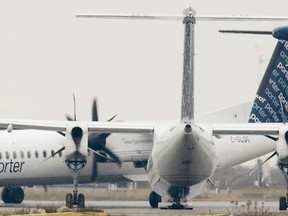Tired flight controller cause for 2010 Porter Airlines near-miss

Article content
TORONTOTwo Porter Airlines planes came within “300 feet” of each other near Toronto after an overly-tired flight controller lost track of their positions, a federal investigator has concluded.
The May 11, 2010 near-miss required a Transportation Safety Board of Canada report, which was released Thursday.
The independent agency does not assign fault or determine civil or criminal liability.
Chief investigator Ewan Tasker concluded Porter Flight 406 from Montreal, with 54 people aboard, was approaching Billy Bishop Toronto City Airport over Lake Ontario as Flight 249 with 37 people aboard took off for Ottawa.
Both were cleared by a flight controller working for NAV Canada, a private, non-profit corporation that owns and operates Canada’s civil air navigation service.
At around 8:39 a.m., “about six nautical miles southeast of the airport, both aircraft responded to resolution advisories from their respective traffic collision-avoidance systems,” the report states. “The aircraft crossed paths separated by approximately 300 feet vertically.”
The pilots of the Dash 8-400 aircraft had radioed their positions, which the controller also followed on radar, Tasker said.
The controller noticed the danger “shortly before the pilots did,” he said. “He alerted them, and within seconds, the pilots responded.”
Tasker said the outbound pilot also reported seeing the incoming plane.
Brought in early for an unscheduled overtime shift, the controller for several months was sleeping an average six hours a night instead of the recommended eight hours, the investigation determined.
Combined with trying to handle “distressing personal matters,” he was suffering from “fatigue.”
His report said fatigue will impair “many facets of human performance,” including reducing “memory and cognitive abilities.”
Tasker said passengers likely did not realize the potential crisis.
The investigation was initiated after a standard Aviation Occurrence Report was submitted by NAV Canada, he said.
Tasker said the controller, who started working for NAV in 2006, was not disciplined, but took steps to get sufficient sleep and avoid future stress.
“I don’t think he realized that he was fatigued,” he said. “Over time, he got over his personal issues and he got much more rest.”
The investigation focused more closely on the May 2010 near-collision incident because of several similar overly-close incidents, in an effort to determine the causes, Tasker said.
NAV Canada “can look at the report” and make its own recommendations, he said.










